
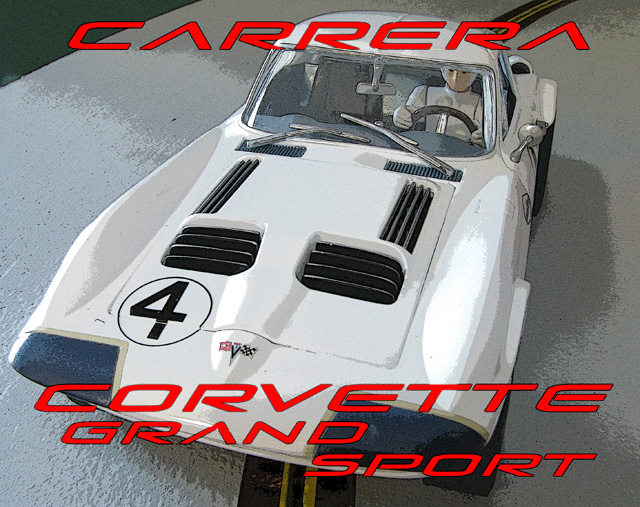 Carrera Chevrolet Corvette Grand Sport Review By Alan Smith 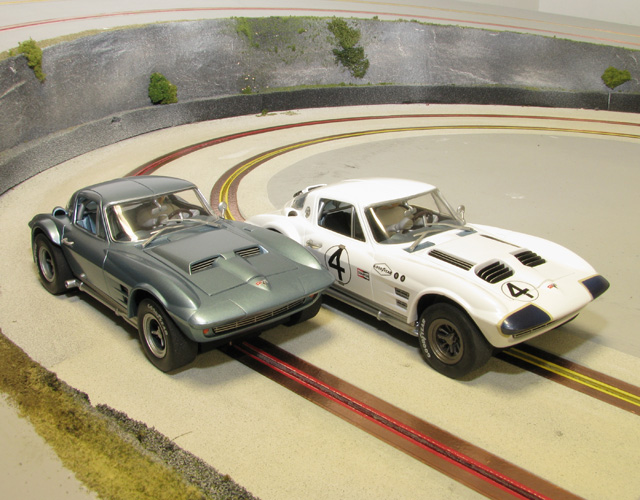 Carrera is going for the checkered flag with many new and exciting Digital 124 releases in 2009. Taking an early lead in the race are two Grand Sport Chevrolet Corvettes designed for both digital and analogue tracks. The white #4 car was raced by Roger Penske and Jim Hall in the 1964 Sebring 12 Hour endurance race. 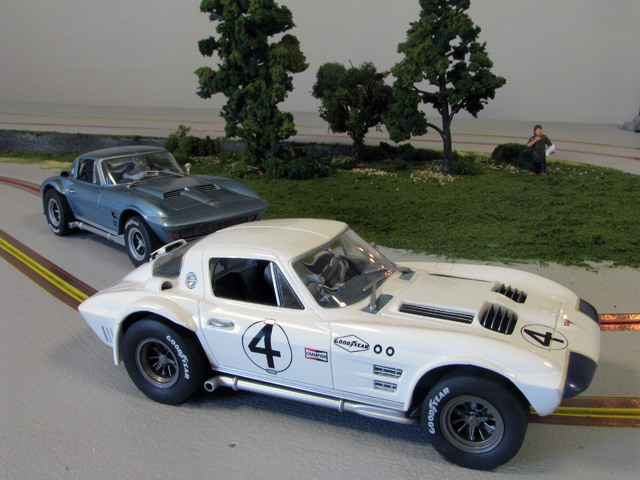 These two racing legends took their Grand Sport to a 1st in class win and an 8th overall finish. The metallic blue car models the Grand Sport rollout or presentation car. These cars were powered by 377 cubic inch small block V8 engines fed by four 58mm Weber carburetors. Horsepower was rated at 485 at 6000 rpm. Known as the “lightweight Corvettes”, these cars were purpose built for competition utilizing special components throughout the chassis and body. Adding to the mystic of the Grand Sport was the backdoor relationship General Motors had with these cars. GM did not officially support factory racing at the time, but GM engineer Zora Duntov was somehow able to build five Grand Sports using factory money, and then went racing by providing the cars to “privateer” teams. Impressions 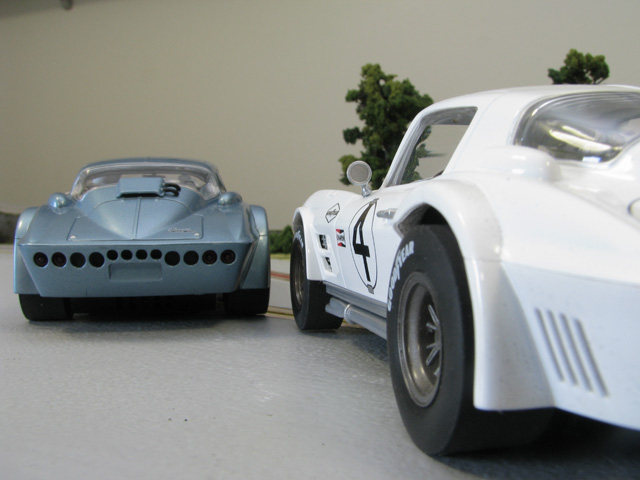 Big Fat Rubber would have to be the first impression most people take with them after viewing the Grand Sport. I did an internet search and nearly every photo of the real car was a rear three quarter view, the view that most emphasizes those massive rear tires. In 1:24 scale Carrera has captured that look for us by creating a dead to rights set of wide Goodyear tires on Halibrand wheels with three spoke knock-off spinners. While the rubber makes the first impression, the lasting impression I get from the car is one of “form equals function”. Every surface of the Grand Sport bristles with functional detailing. Oil cooler, exhaust headers, wheel flares, air vents, air scoops and still more air vents. This purposeful look has much to do with the lasting appeal and fascination that keeps the Grand Sport in racing legend four decades later. 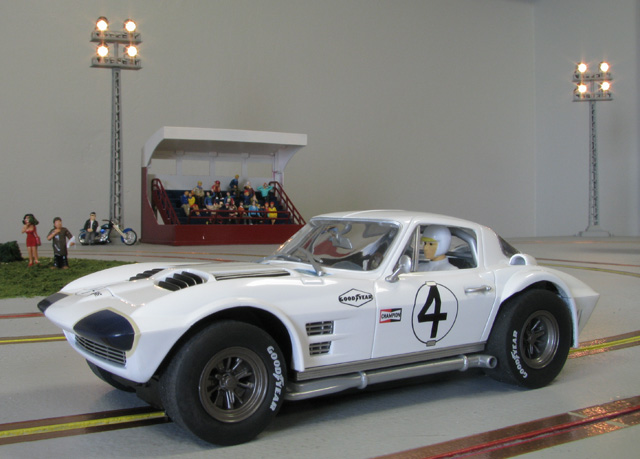 The Sebring race version is painted gloss white with metallic blue and silver trim. The presentation version is solid metallic blue with silver trim. Both have paint finishes that are blemish free and gloss coated. 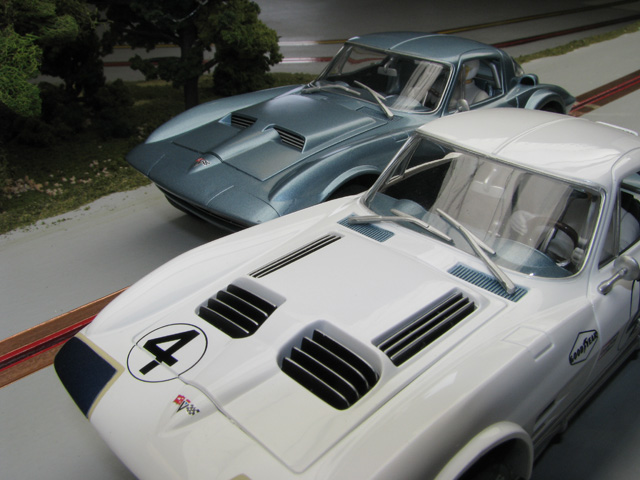 The two cars have different hood treatments, the race car has large air vents facing the sky, while the presentation car has a large forward facing air scoop. The story behind the difference is that race testing uncovered significant front end lift at speed, and the air vents were added keep the car on the ground. Tampo printing on the racing version is sparse, only number roundels and two sponsorship decals on each side. Both versions have very nicely done manufacturer emblems front and back. All the Tampo printing is crisp and opaque. Body 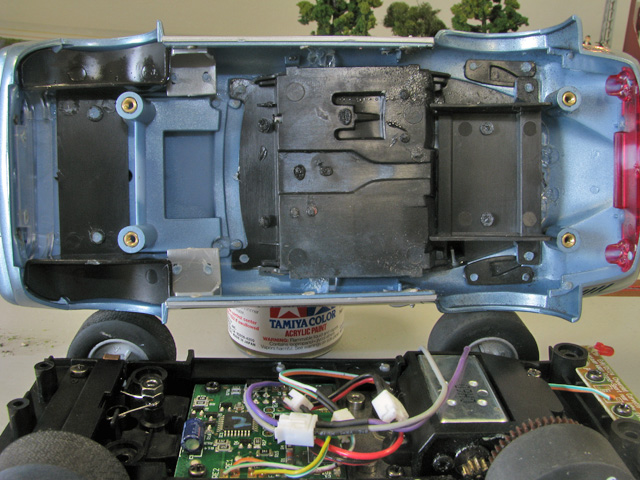 Call me a fan boy if you will, but I appreciate Carrera’s continued use of threaded brass inserts and machine screws for body mounting. This small touch adds a sense of quality, durability, and value that I find missing in many of the smaller scale cars. Once removed from the chassis the body remains a single assembly that feels surprisingly light. Most of the body details are separate castings held in place by melted plastic positioning pins. The hood also appears to be a separate molding and interchangeable between the two cars. Disassembly for a repaint should be easy enough, and I predict there will be many repaints and custom versions of this car. 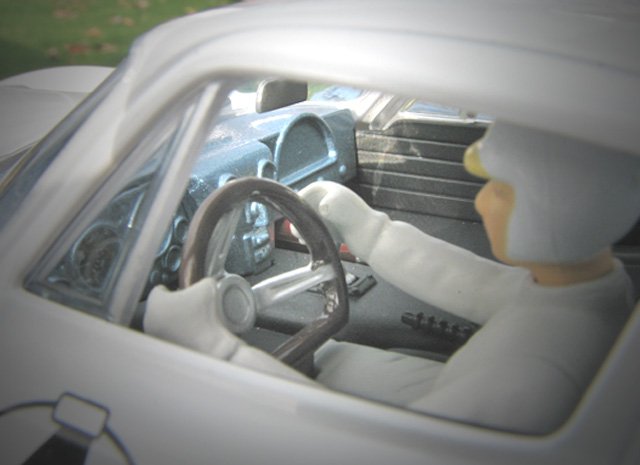 Open side windows provide an excellent view of the half tray interior. Cockpit details include roll bar, fire extinguisher, handbrake, gear shifter, and the iconic Corvette half moon glove box on the dashboard. The driver figure is painted all white except for flesh paint, black eyes, and a bit of yellow trim on the helmet visor. Very plain looking, plain looking enough to pass for an Amish horse and buggy racer. I wish Carrera would step up with more helmet detail, a racing harness, and some contrasting paint on the driver’s suit. Many of their open cockpit models already have this type of driver detailing. Chassis 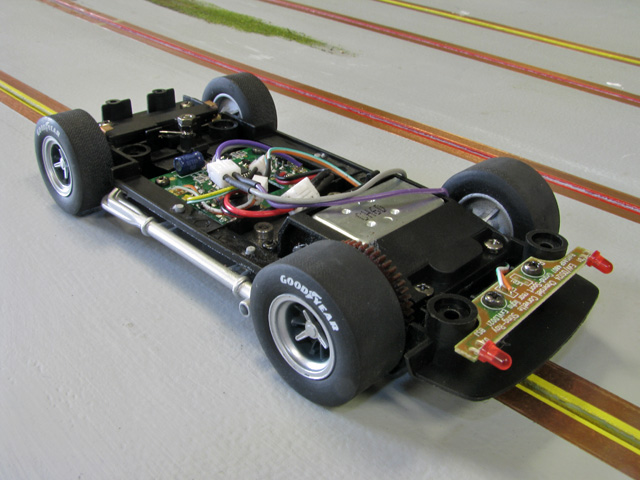 Digital 124 cars roll off the transporter and onto your track with simple yet effective adjustments for chassis tuning. Front and rear chassis height can be adjusted by reversing a plastic spacer under each axle. This change increases the chassis to track clearance and is intended to help the car clear the short transitions found on Carrera banked track sections. On the traction end of the car this height adjustment requires removal of the motor, a process that requires deliberate but not tedious effort.  The drop arm is adjustable using a Phillips screw that extends the drop arm from its recessed position in the chassis. This adjustment is used to balance how much of the car’s weight rides on the guide flag, and how much weight rides on the front wheels, essential to achieving the perfect tripod effect. The drop arm body has an enclosed spring that helps center the guide flag, and the guide flag itself is designed to snap on and off. The guide flag is on the long side but can be easily trimmed for length. The snap in feature allows you to quickly swap between stock and trimmed flags as needed for different tracks. A spare flag is included with the car. 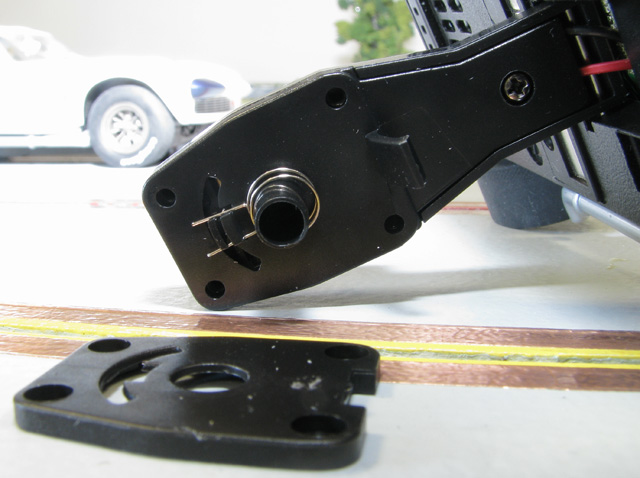 The double pickup brushes also snap in and out for easy cleaning or replacement, and a spare set is also provided. And for the piece de resistance a brass transverse leaf spring provides a suspension system for the front wheels. Of course the car has a solid front axle, so this system falls short of being an independent suspension system. 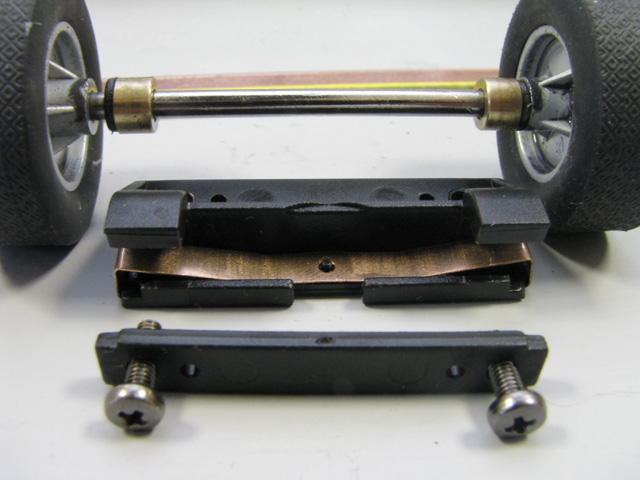 Magnets are positioned between the rear wheels, and behind the drop arm pivot, slightly rear of center. The center magnet is actually three separate magnets, allowing one or more to be independently removed. Shims are provided to adjust down force by moving the magnets closer or further from the track. 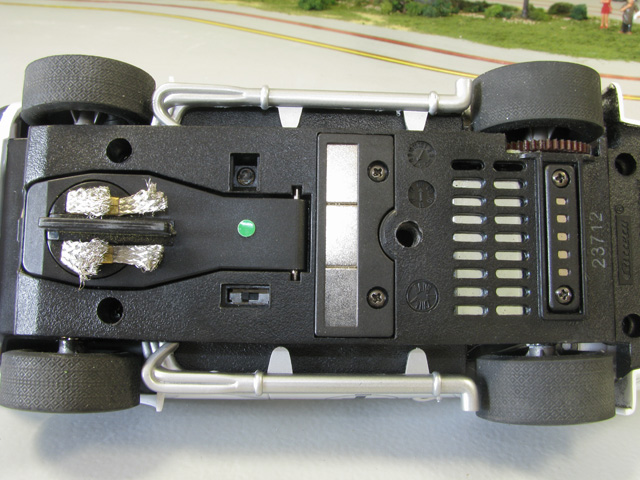 The motor is a sidewinder mount with a 10-tooth pinion gear and a 50-tooth spur gear. Also found under the chassis is a sliding switch for direction control and the lane change LED. Reconfiguring the car for analogue tracks is as simple as putting the car on the track, blipping the controller three times, and sliding the direction switch over. In analogue mode the directional switch continued to work normally, and the car remained in analogue mode even after the digital board was removed and later reinstalled. 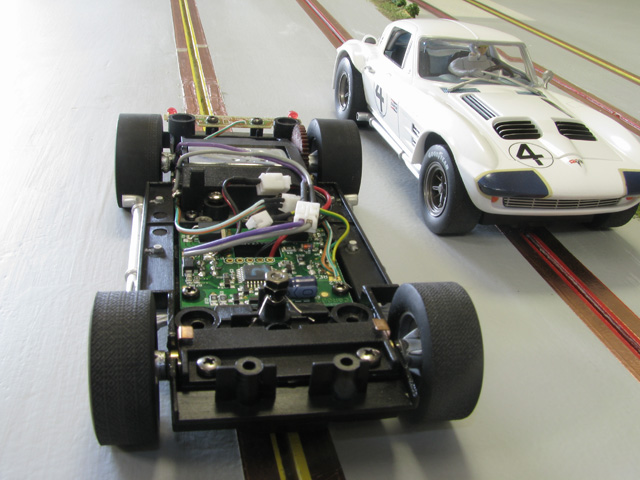 The digital board and lighting connections are all joined together with plugs, no soldering required. Power for the LED lighting is routed through the digital board, so removal of the digital board would mean lights out. The Grand Sport is modeled with tail lights only, no headlights. Handling 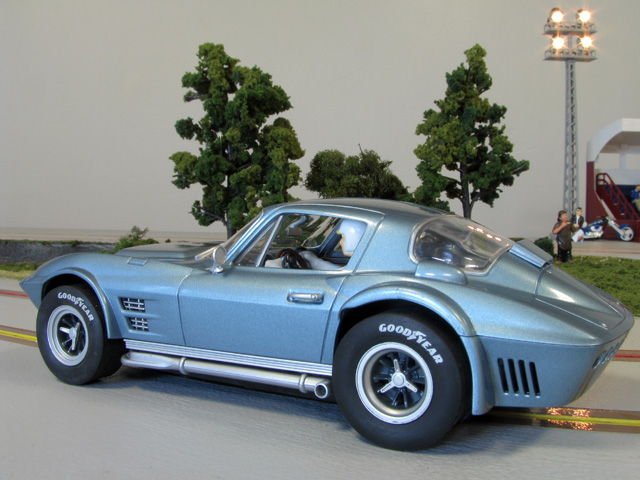 The blue presentation version received first lap honors, straight from the display case to the track. Joy quickly turned into disappointment as the car rumbled noisily down the straights, hopped through the corners and snap rolled without warning. A quick pit stop and visual inspection found nothing wrong. Gear and axle lube were applied, tires were sanded, and binding points were searched for. Nothing helped. Disappointment mounting, I decided the photo shoot could wait and I reached for the still pristine white race version. 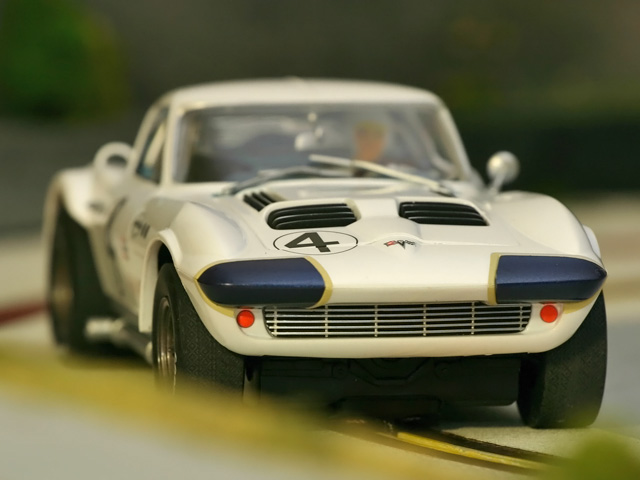 Immediate improvement, smooth acceleration and power sliding replaced the terrible handling displayed by the presentation car. Faith restored, I lubed the white car and ran her for a half-hour exploring handling traits and taking numbers. Best lap time was 6.15 seconds with an average of 6.33. The presentation version continued to struggle and posted a dismal 6.85 best lap. Knowing there must be something amiss, a closer examination of the presentation Corvette followed. 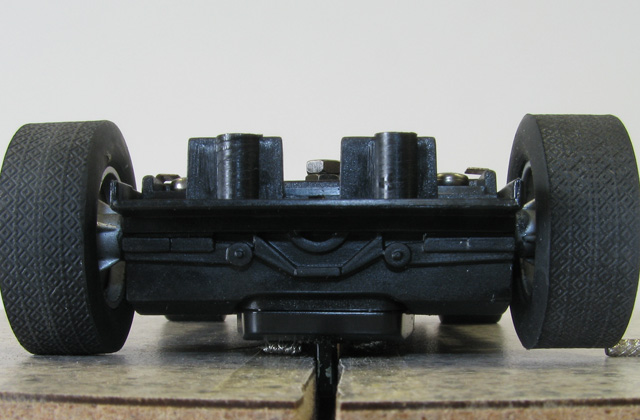 With the car on my setup block and held up to eye level, the problem fairly jumped out and bit me. The left front tire was grabbing nothing but air while the other three were firmly planted. But why? Warped chassis? Visions of stripping the chassis bare and soaking it in hot water ran through my head. But the real world intervened and it wasn’t until a week later when I removed the front axle for photos, that the cause of the problem revealed itself. The front axle adjustment spacer had not been properly installed, causing the left front to sit higher. After reassembly all four tires met the track evenly and the quirky handling problems were history. Comparisons Having recently reviewed Carrera’s Ferrari GTO, Chevrolet vs. Ferrari comparisons would only be natural. My test track is routed wood with some very tight radius turns. It has several coats of magnetic paint covered by flat latex primer. 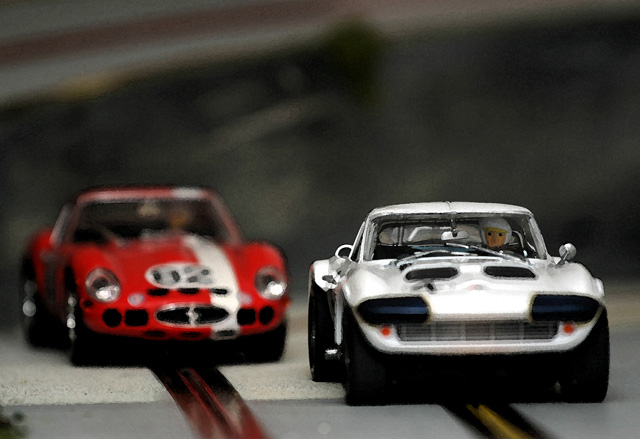 On my track, the Ferrari is the faster car, with a 5.75 best lap, and a 5.88 average. The Corvette and Ferrari are equal in acceleration but the Ferrari out corners the Corvette. When pushed hard the Corvette tends toward wheel hop and sudden loss of cornering traction, as opposed to the more progressive and controllable Ferrari. If the rear swings out far enough, the guide hits the hard limit and the guide flag pops out. I call it the click of death for the distinct sound you hear when it happens. 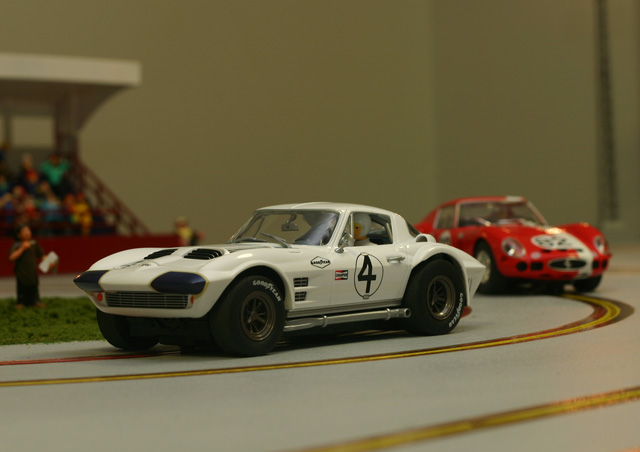 Sometimes the flag only pops halfway out and the car continues to run with front wheels in the air and pickup braids barely in contact. Sometimes the flag stays in the slot while the car continues on and crashes into your scenery. All of the time, the car needs to be flipped over so the flag can be popped back in. Its a race marshaling nightmare and just plain annoying for the solo racer. Without access to another test track I cannot predict what your mileage might be, just know that you have been warned. 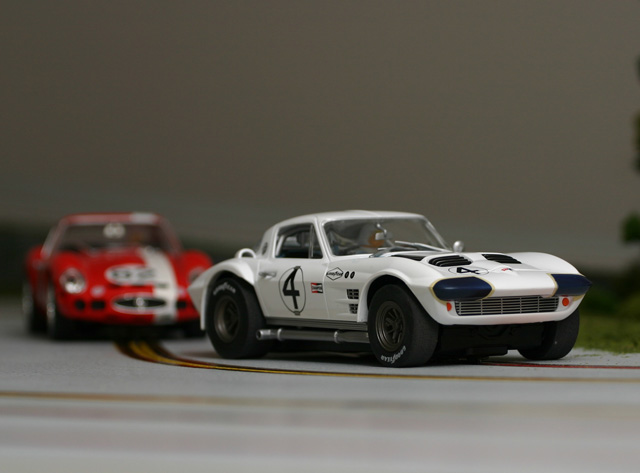 The click of death happens to the Ferrari as well, but its rear tires are half the width of the Corvette monsters, and are made with a softer composition rubber as well. In this scenario, less grip and more slip equals greater control and faster times. Sanding the tire edges on the Corvette reduced the hopping, but only just. A softer tire compound like urethanes could help, and of course there is always silicone. Removing the magnets made the car loose in the turns and only aggravated the problem. The solution for me is to dial down to 14 volts, drive a bit less aggressively, and enjoy. Conclusion 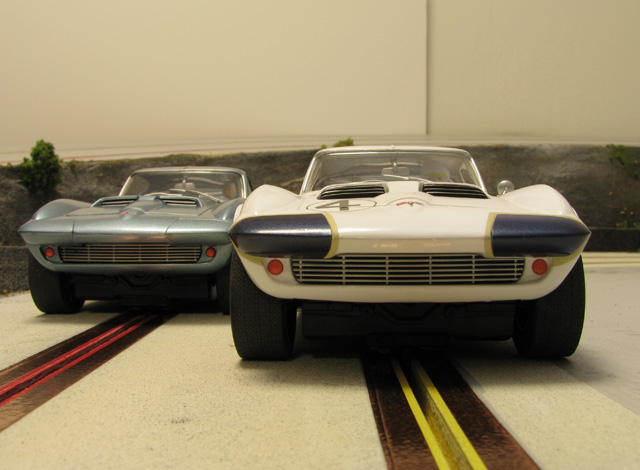 Wrapping things up, my opinion is an overall positive with some reservations for the guide flag click of death, hard tire compound, and quality control issue. Tires can be changed but the guide flag system is not so easily modified. Hopefully Carrera engineers will find a solution before long. My suggestion would be a flag that slides back to lock and forward to unlock. This would keep the flag in place when the car is running, but still allow it to be easily removed when needed. 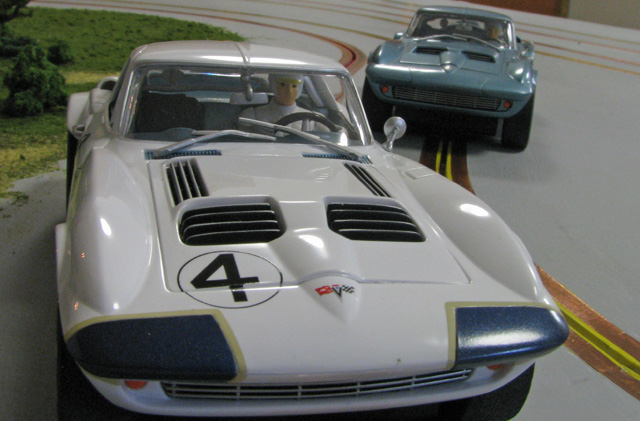 As a hobbyist, tracking down the cause and solution for a poor performing car just adds to the fun and satisfaction. However for the family or individual with their first starter set, having two cars with grossly uneven performance could be enough to pack the set up and write the hobby off. I enjoyed photographing and reviewing these two cars, but I do regret not being able to test in digital mode and on Carrera track. Rumor has it that Carrera will be releasing several more Grand Sport liveries in 2009. So stay tuned for future reviews and my shot at redemption. Alan Smith - Asmith Email me about this article |